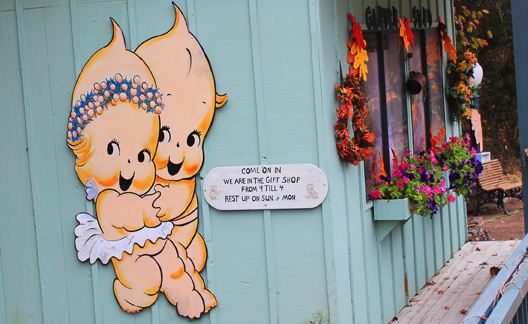
plate 1. Kewpie signs welcome Bonniebrook visitors regardless of season.
Festival of the Painted Leaves 2015, Bonniebrook
by Stephen Meek
“I had a Tom Sawyer life and I didn’t miss electricity,” declared Leon Combs before going on to relate more of his unique biography. He had, in fact, been dropped off at his adoptive parents’ Bradleyville home by none-other than the mailman: the only person in the area with a “car going that way.”
Combs, author of Hicks from the Sticks and Bradleyville My Hometown, boomed over the microphone at Bonniebrook, former home of Rose O’Neill and her famous Kewpies. He was keynote speaker for the Festival of the Painted Leaves, an event celebrating Ozarkers past and present. Combs exemplifies the hillfolk for which the festival was created. In his own words, he was a “local boy done well — [a] local boy [who] did not forget his roots.”

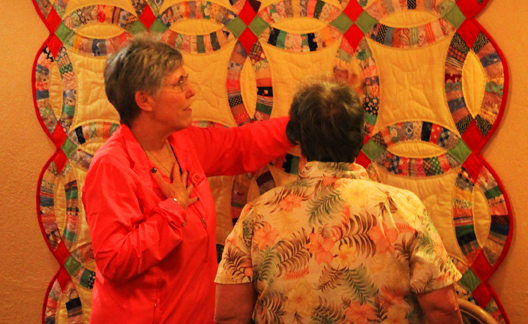
plate 2 & 3. It’s difficult to escape the gaze of O’Neill’s iconic Kewpies, even when rendered in paper mache (top). A complex wedding ring pattern is discussed (above). Participating organizations included the Missouri Humanities Council, the White River Valley Historical Society, the Branson Arts Council and the Finley River Fine Artists.
Though Combs grew up in a rural world without electricity, his education took him far as he became successful enough to buy a college and start several truck driving schools. Though Combs’ career kept him away from his Ozark roots for many years, these were roots he clearly never forgot. In time he came back to Bradleyville to research his first book and settled right back in — though this time with electricity! He and his wife Dorothy own the 3,000-acre Beaver Creek Elk & Cattle Ranch.
Later, as Kim McCully-Mobley (adjunct professor from Drury University and Vance Randolph specialist) mentioned Randolph as attending the last legal hanging in Missouri — which occurred in nearby Galena in 1937— Combs spoke up. “My family owned the land on which the hanging took place!” This footnote in Ozarks history was not the only one brought to light by the festival.
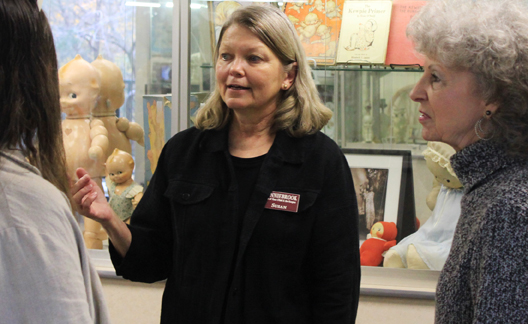
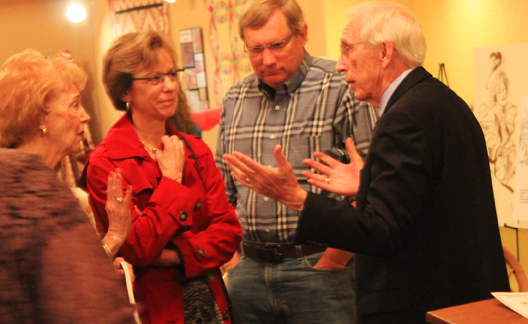
plate 4 & 5. Top, tireless Rose O’Neill advocate Susan Scott explains Kewpie-related history to attendees. Above, Leon Combs (at right) speaks with guests including Jean Cantwell (at left).
In her introductory speech, organizer Susan Scott mentioned a nearly forgotten organization called the “Hillcrofters,” which included both Randolph and O’Neill. Both were good friends and, according to McCully-Mobley, both often told each other bawdy stories. “He was the ‘saltiest of the oldtimers,” shared McCulley-Mobley of Randolph before regaling the audience with a story from his now-famous book Pissin’ in the Snow & Other Ozark Folktales. “He helped O’Neill with her autobiography and other stories she wrote.”
The biographies of O’Neill and Randolph have become relatively well-known. However, the life of Ozark poet Mary Elizabeth Mahnkey has remained obscure. During the festival, Mahnkey’s great-great granddaughter Angel Wolf shared stories of her ancestor, many directly from the poet’s crab-handed journal. When Mahnkey was just a young girl, the family moved to Kansas by covered wagon. During the move, Mahnkey fell in front of the one of the wheels, leaving her fingers crushed. It took the poet considerable skill to surmount the disability, and, as Wolf noted, her journals are nearly illegible to all but a few.
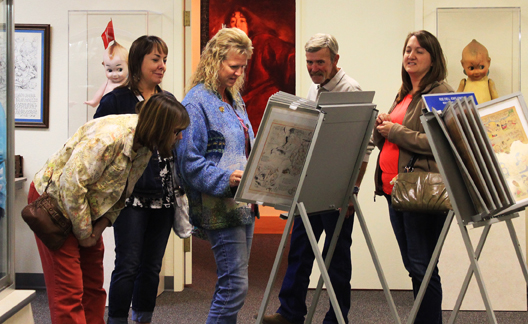
plate 6. A bevy of O’Neill fans browse the artist’s classic magazine illustrations before entering the Sweet Monster gallery beyond.
Wolf shared other personal stories about the family as well. Mahnkey’s father Alonzo Smith Prather moved the family to Kansas to protect them from the Baldknobbers, the mountain vigilante group he had helped found! While in Kansas, the young Mahnkey was picked up by a pair of traveling Osage Indians and taken for some distance before the pair decided to return the child to her home. Not everyone can claim a near-abduction by Indians on the prairie in their biography!
Between sessions, I explored the booths and talked to folks. The speakers, the Missouri Master Gardeners and a local quilter all had tables lining the walls. Chili and cornbread by Made in the Shade caterers of nearby Walnut Shade, Misosuri, was provided for hungry attendees.
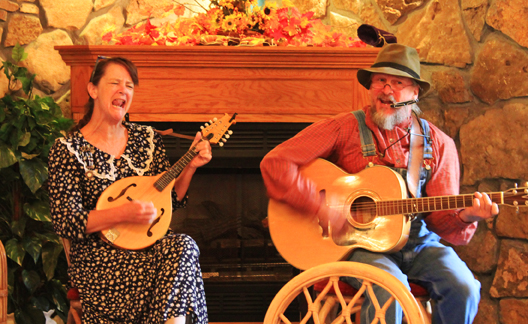
plate 7. Nancee and Mike Micham (Ez’N’Dil) perform traditional Ozark songs.
During the midday break, Mike and Nancee Micham (Ez’n’Dil) played heartwarming Ozark music. I explored the other wing of the building housing the Kewpie collection and O’Neill’s Sweet Monster gallery. Kewpies appeared to glance sideways out of the corner of their big eyes while the Michams lilted through a number of folk-infused hill melodies. I could tell it would be a uniquely Ozarkian afternoon.
Lisa Pluth, a third-generation master herbalist, spoke warmly about the plants she found on her land at Purple Gate Farm near Highlandville. Her presentation covered everything from when it is okay to drink hemlock to what a maypop does when you throw it at a fence post! Perhaps not surprisingly, it pops! She also taught her techniques for making tisanes, or “herbal teas consumed for medicinal properties.”

plate 8. Steve Otto grimaces theatrically as he engages his listeners in a traditional Ozark tall tale.
Another lively speaker was Steve Otto, a member of several storytelling guilds and the Missouri Humanities Council. His voice lilted over us and I hung on to every word. One tale progressed thus:
As a small boy, he went fishing with his father one morning and noticed something strange: a black walnut centered perfectly on a riverbank hickory stump.
Thinking it odd, he pointed the lone walnut out to his father. Neither could make heads or tails of how a walnut could have fallen from an overhead branch and landed so perfectly centered on the hickory stump.
As they sat there watching, a squirrel hopped over, jumped onto the stump and broke open the hard-shelled nut with his teeth. Suddenly, an enormous catfish lunged from the water and swallowed the squirrel!
Otto couldn’t believe his eyes and asked his father if he’d ever seen such a thing (his father hadn’t). Returning their attention to the stump, they sat there, waiting. They didn’t have to wait long. A few moments later, that same catfish burst from the water, struggled onto the stump, then fell back into the now-murky river.
And on the stump, the catfish had left another black walnut.
Otto’s story caught me by surprise and I burst out laughing. Several other stories had the same effect. Otto concluded, “My secret is to follow Mark Twain’s three rules for storytelling.
“First, you’ve gotta have a beginning. The beginning is what reaches out to your audience and pulls them in.
“Second, you’ve gotta have a storyline with three times where the audience thinks, ’Somethin’s gonna happen!’
“Third, you’ve gotta have a great ending. I just wished Twain would have added one more and that one’s mine:
“ You gotta know when to quit!”
October 28, 2015




